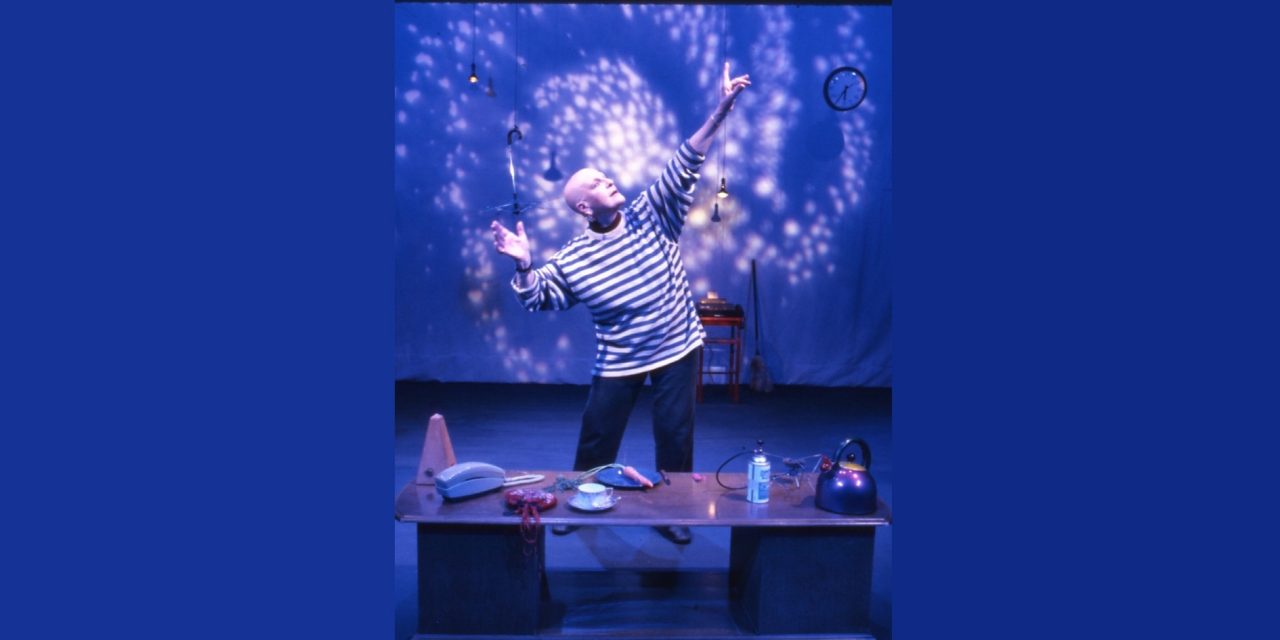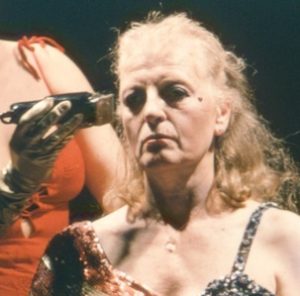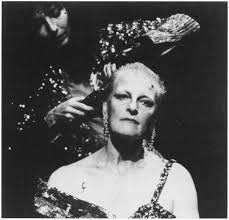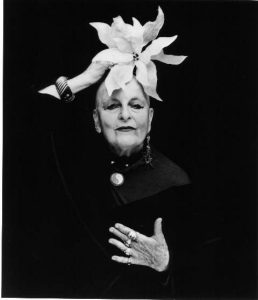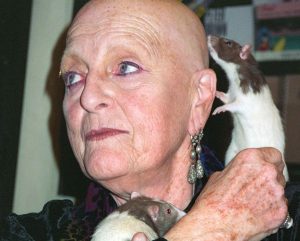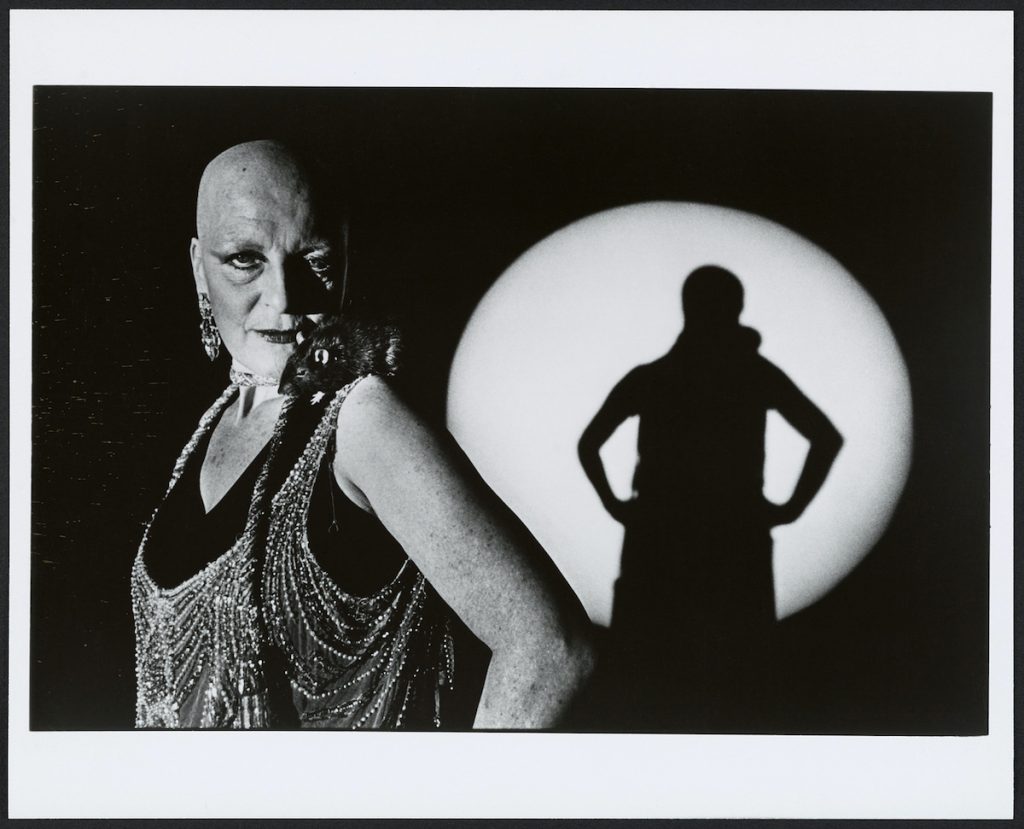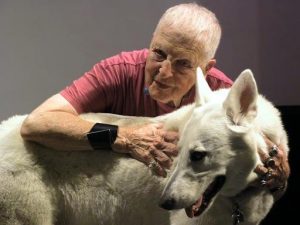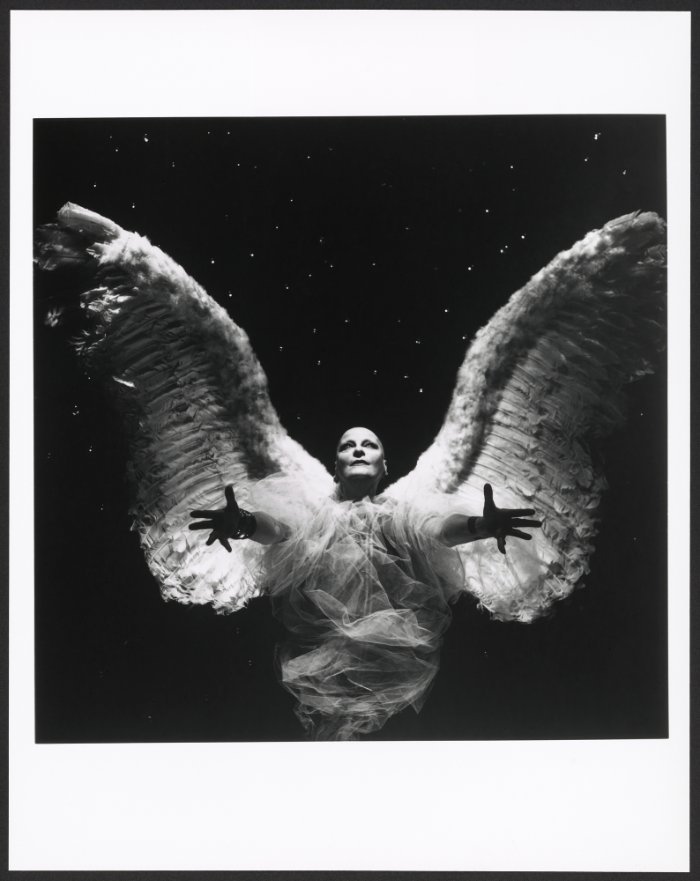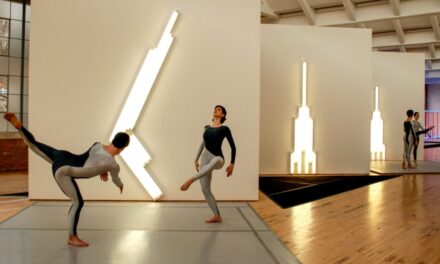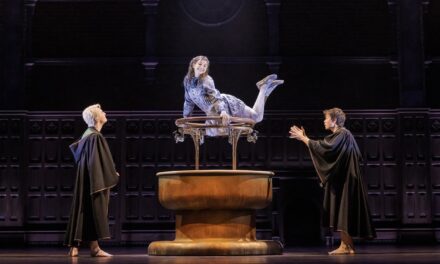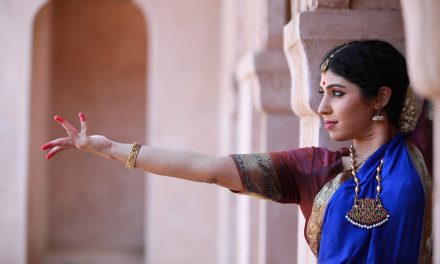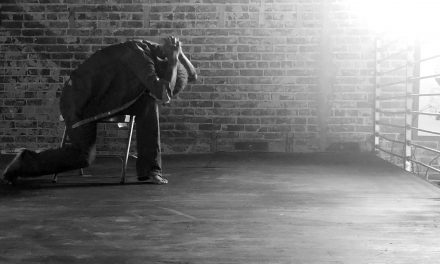She studied ballet in Paris until her Jewish family fled the Nazis, first to Portugal then to Brazil, and then to New York. After WWII, she traveled between the U.S. and Paris, studying Antonin Artaud’s provocative, assaultive theatre of shock and then falling into the ambit of John Cage and Merce Cunningham. She was deeply influenced by Cage and did time in Cunningham’s junior company. Later, after settling in Los Angeles in the 1950s, her distinctive, audacious assembling of dance, theatre, art and politics took root and came to define Rachel Rosenthal who became known as the “doyenne of performance art.”
Her art was performed live, in the moment, fueled by chance and often described with terms like “take no prisoners.” Despite struggles with osteoarthritis starting in the 1960’s, Rosenthal was known for her ferocity, distinctive voice, and fearlessness. After having her head shaved onstage, that bald pate became a signature along with her many dogs and pet rats. Her school and her company strongly influenced a generation of performers and performance venues including Highways Performance Space in Santa Monica. A prolific writer, notetaker, and video collector, Rosenthal’s archives spanning her life from 1926 to her death in 2015 have been acquired by the Getty Research Institute (GRI). The new archive adds to the GRI’s acquisition of archives from significant, mostly female artists whose work shaped the art of dance and performance including Yvonne Rainer, Carolee Schneemann and Barbara T. Smith.
One of the curators overseeing the acquisition, GRI senior research specialist Zanna Gilbert reports that intriguing nuggets already have been unearthed linking with the Barbara T. Smith archive.
“Rosenthal’s archive contains a folder of letters from Smith, the other side of an extended correspondence between Smith and Rosenthal, that matches up with the corresponding letters in Smith’s archive,” Gilbert described, “We now literally are able to put the pieces together across these two archives – it makes an acquisition all the more exciting when it speaks directly to the collections we already have.”
The GRI acquisition has also drawn attention to her eponymous Rachel Rosenthal Company which continues under current artistic director and long-time associate Kate Noonan. Just after the Getty announcement, the Rosenthal’s company made its own announcement that Rosenthal’s long-time studio on Robertson Blvd., which was under refurbishment until the pandemic, now is ready to reopen to continue Rosenthal’s legacy from the company’s original home.
“The Company has been active up until Covid. We have been presenting our ensemble, Tohubohu! Extreme Theatre Ensemble, for the past 15 years, doing monthly totally improvised performances. We took time off so I could do some repairs to the building and had hoped to do a big re-launch of the space to coincide with the Getty announcement, but obviously that didn’t happen.”
Noonan and Tad Coughenour, a former company member and tour manager were also involved in lengthy preparations for the GRI acquisition in assembling an inventory of the extensive archive.
Gilbert confirmed that Rosenthal’s archives were on the Getty’s radar for some time. In 1994, Rosenthal worked with GRI Chief Curator Marcia Reed on an exhibition titled Connections 2: Explorations in the Getty Center Collections. Rosenthal was one of the artists selected to create an installation drawn from GRI Special Collections. “Among the participating artists she was memorable for always bringing her dogs whenever she came to the Getty. Even back then, she said she wanted her archive to come to the GRI,” Gilbert said.
The inventory project was daunting. The archive contains approximately 30 scrapbooks containing information collected by Rosenthal; 60 journals containing notes about performances; several sketchbooks and handmade unique artist books; more than 1500 photographs, as well as 800 slides and 350 negatives; more than 500 pieces of mail art; around 800 letters; hundreds of pieces of ephemera; artists’ books and magazines; scripts and notes for performances; around 2000 video cassettes, and several hundred audio cassette tapes. The archive will be available for research and exhibition after GRI staff complete the cataloguing of the trove.
What can’t be included in the GRI collection is Rosenthal’s influence on SoCal dance and performance scene. While described as a performance artist, Rosenthal’s work was a hybrid of theatre and performance, and her legacy was finding techniques to replicate work created for the moment, according to Noonan.
“Performance art was almost always a one-time event in real time, and Rachel changed the face of the art by teaching how to structure, rehearse and repeat performances, that made grants and touring possible. Rachel was not only a powerhouse performer, she was a generous teacher, she loved artists and wanted to nurture that impulse.”
One frequent stage for Rosenthal’s creative impulses was Santa Monica Highways Performance Space. Highways hosted at least a dozen Rosenthal performances over the years including what may have been her last performance before resigning herself to directing, teaching and influencing a new generation of performers steeped her aesthetic.
Highways Executive Director Leo Garcia who curated that Highways’ 15th anniversary celebration in 2004 vividly remembers Rosenthal and that 2004 performance.
“When initially invited, Rachel said she was no longer performing but agreed to prepare something for Highways. She had been a part of Highways since its opening Gala Benefit on May 4, 1989. Here she was with us 15 years later and opening the show,” Garcia recalled.
The 15th anniversary event included more than a dozen important performers including Jackie Apple, Michael Kearns, Barbara T. Smith, and Rudy Perez, each presenting a new work and everyone, including Rachel, promised Garcia to keep to 7 minutes, critical with that many performers. On the big night, Leo remembers Highways already was packed so tight that the floor was flooding over with people before the show started.
“Rachel was the first one up … and she remained on that stage joined at intervals by friends, each of whom entered with their dogs until the space was filled with at least 30 dogs and their owners,” Leo recounts. “By the time Rachel’s piece was completed we were already 40 minutes into the evening, with eleven works to follow. It became quite a marathon, but in the end her work was historical, a brilliant evening. People loved her and I was grateful to host her last performance work.”
Garcia still has Rosenthal’s notes for that Highways’ performance dubbed Painting is Hell (a Doggy Reality Show) including rehearsal notes identifying who was to bring up her three dogs, a list naming each dog with its human participant, and instructions after the rehearsal for owners to return the dogs to their car with a reminder to leave the window rolled down to provide air for the dogs.
Those notes may well be among the trove GRI staff will start to catalogue once the current Covid-19 shut down ends. GRI Chief Curator Miller confirmed that Rosenthal will be a major figure in an upcoming research project on women artists archives exploring the relationship between archive and performance.
Gilbert also confirmed that public performances and screenings are being planned as occurred when the Yvonne Rainer archives went on display. Before that Noonan and her colleagues will be continuing the Rosenthal legacy of audacious risk and chance with classes, workshops and performances on the artist’s old stomping grounds.
Written by Ann Haskins for LADC, June 6, 2020.
To visit the Rachel Rosenthal Company website, click HERE.
To learn more about the Getty Research Institute, click HERE.
Featured image: Rachel Rosenthal in performance – Photo by Kevin Adams

